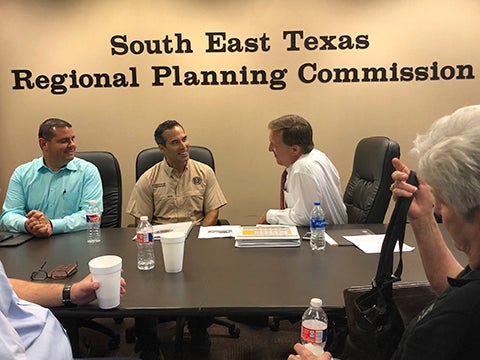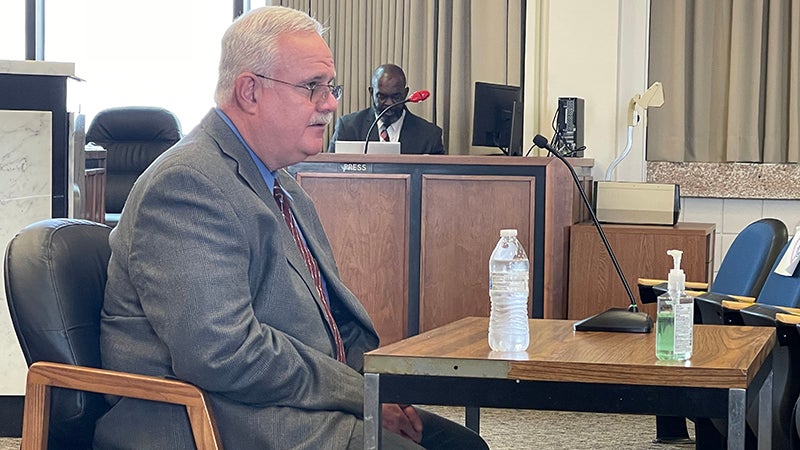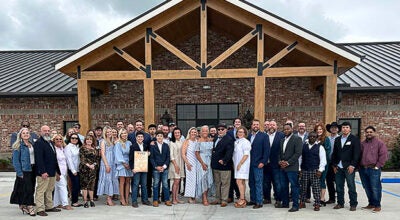Funding to prepare: Billions due for Port Arthur levees
Published 11:16 pm Friday, July 6, 2018

- Texas General Land Office Commissioner George P. Bush, center, talks to Jefferson County Judge Jeff Branick about mitigation funding during a meeting at the Southeast Texas Regional Planning Commission on Friday. (Chris Moore/The News)
By Ken Stickney
and Chris Moore
ken.stickney@panews.com
chris.moor@panews.com
BEAUMONT — Judge Jeff Branick said Friday that Jefferson County held key advantages in securing federal funds this week for levee construction in and around Port Arthur.
One advantage is that Greater Port Arthur and environs have been studied “for several years” for flood protection improvements. The other is that the chief of the U.S. Corps of Engineers has signed off on a project report.
Branick met with Texas General Land Office Commissioner George P. Bush and other officials at the Southeast Texas Regional Planning Commission on Friday to discuss plans regarding the funds.
“We’re excited, with Congress’ action, to make that historic appropriation for Southeast Texas to fortify levee systems to stem against storm surge,” Bush said. “As part of the effort our agency undertook along with elected officials like Judge Branick, we were able to find ways to source money for levee fortification. As we clear debris, rebuild homes in communities and get work places back and running, it’s also important to be prepared for the next storm.”
“I would not expect people to turn dirt next week,” Branick said, explaining that some 27 agencies must be hurdled for project permits. But the money is there, he said, including money for preliminary designs and land acquisitions for hurricane protection levees.
Almost $4 billion of the $5 billion allocated this week for Texas flood control projects is targeted for Jefferson and Orange; six coastal counties will be aided, in all. The money will bolster or build 30 miles of levees around Port Arthur and up the Neches River toward Beaumont, Branick said, as well as some levees around Freeport, south of Galveston. Some money is also allocated for building coastal levels in Orange County.
The U.S. Army Corps of Engineers announced Thursday that $5 billion for disaster-recovery projects is being funded for flood mitigation that includes high-priority projects in Texas.
“The billions allocated to Texas today is welcome news as we continue to rebuild in the aftermath of Hurricane Harvey,” Abbott said in an issued statement. “This funding will go a long way toward future-proofing Texas against another hurricane and strengthening our infrastructure to withstand dangerous flooding.”
The governor’s office said funding includes projects from Sabine Pass to Galveston Bay — $3.9 billion — but Branick said that includes the Port Arthur-area projects.
He said Friday that he had discussed the project in the morning with U.S. Sen. John Cornyn’s office.
Branick said the six coastal counties that will be aided have more than 5 million people in total as well as 40 percent of the nation’s energy infrastructure and three of the top six U.S. ports.
“I’m thankful for the appropriations that allow us to move forward more quickly, protecting homes and industries,” he said.
U.S. Rep. Randy Weber, R-Friendswood, who represents Jefferson and other coastal counties, said in an issued statement:
“This levee system will help protect our homes, neighbors, and communities from the threat of quick-rising water that has caused damage one too many times. Additionally, the Texas Gulf Coast plays a leading role and for our nation in terms of economic contributions. When our refineries, pipelines, and seaports along the upper Texas Gulf Coast are disrupted by natural disasters, the entire nation sees the effects.”
Bush said that the fortification of the levees is imperative to help Southeast Texas with future storms and flooding.
“Those levee fortification systems were studied by our agency and we’ve worked with Judge Branick to make sure we are prepared for the next one,” Bush said.
“That work continues to be ongoing for the Corp of Engineers. We continue to press them to move forward, because there are always vulnerabilities in every hurricane season that comes to a community like Southeast Texas.”





